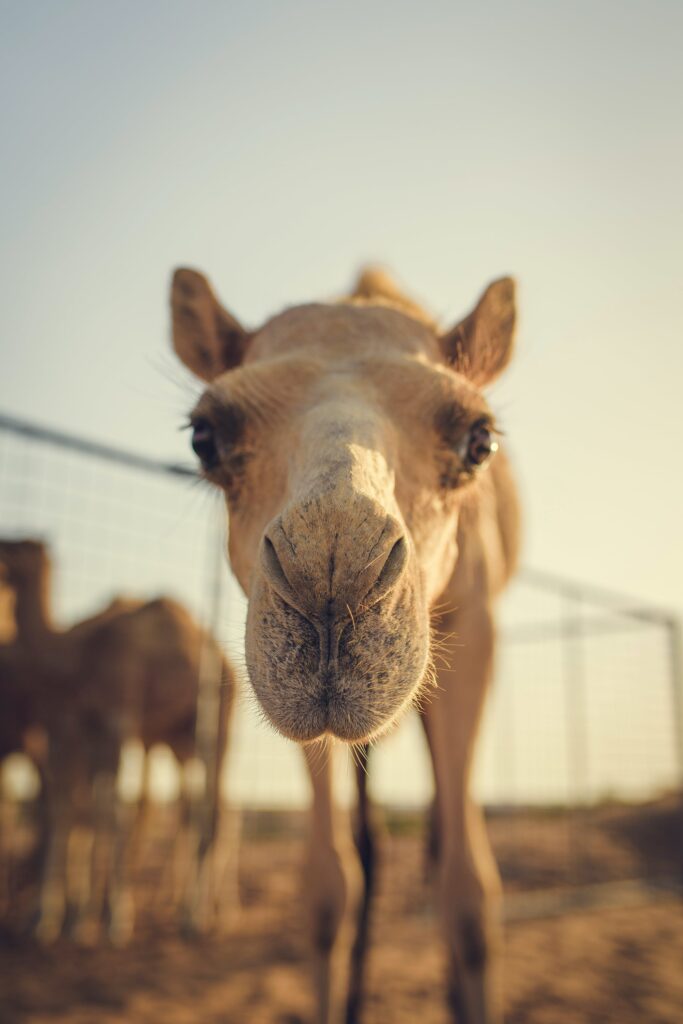Hello Everyone Here is your inquiry:
10 Interesting Facts About Camels: Delve into the captivating world of these desert giants with a journey through their unique adaptations, behaviors, and conservation efforts. Did you know that camels can drink up to 40 gallons of water in just 10 minutes? Their remarkable ability to conserve water and thrive in arid environments is just one of the many fascinating facts about these resilient creatures. From their iconic humps, which store fat for energy, to their specialized diets capable of extracting moisture from thorny plants, camels are truly remarkable survivors of harsh desert landscapes. Moreover, their social behaviors, such as spitting as a defense mechanism and forming hierarchies within herds, add to their intrigue.
Beyond their biological marvels, camels play a crucial role in sustaining fragile desert ecosystems through grazing and fertilizing the soil with their droppings. However, they also face threats such as habitat loss and climate change, prompting conservation efforts to safeguard their future. Understanding these 10 interesting facts about camels not only deepens appreciation for these animals but also underscores the importance of protecting their habitats and ensuring their continued survival for generations to come.
From their characteristic gait to their communicative vocalizations, each behavior serves a specific purpose in their social structure and survival strategies. For instance, camels are known for their tendency to spit as a means of expressing displeasure or asserting dominance. Additionally, their ability to kneel down allows for easier loading and unloading of cargo, making them invaluable companions for desert nomads and traders throughout history.
Moreover, camels display remarkable intelligence and emotional depth, forming strong bonds with their human caretakers and fellow herd members. These enduring connections highlight the intricate relationship between humans and camels, which has shaped cultures and economies across the globe for centuries. As we unravel the mysteries of these extraordinary creatures, it becomes evident that camels are not just symbols of resilience and endurance but also ambassadors of the desert’s rich biodiversity.
Camels also play a crucial role in sustaining fragile desert ecosystems. As they graze on vegetation, they help control plant growth, preventing overgrazing and desertification. Furthermore, their droppings serve as natural fertilizers, enriching the soil and supporting the growth of new plant life in barren landscapes. Additionally, camels have been indispensable to human societies for millennia, serving as reliable means of transportation and sources of food, milk, and wool. Their ability to carry heavy loads across long distances has made them invaluable companions for traders, explorers, and nomadic tribes traversing vast desert expanses.
Moreover, camels have captured the imagination of people around the world, becoming iconic symbols of exotic lands and adventurous journeys. Their stoic demeanor, graceful movements, and enigmatic gaze have inspired artists, writers, and filmmakers throughout history. From ancient caravans crossing the Silk Road to modern-day desert safaris, camels continue to enchant and enthrall with their timeless allure.
Yet, despite their cultural significance and ecological importance, camels face numerous threats to their survival in the modern world. Habitat loss, climate change, and overexploitation pose significant challenges to wild camel populations, while domestic camels are vulnerable to diseases and mistreatment. Conservation efforts are underway to protect these magnificent creatures and ensure their long-term survival. By raising awareness, supporting sustainable practices, and preserving their natural habitats, we can safeguard the future of camels and the delicate ecosystems they inhabit.
In conclusion, camels are much more than desert dwellers; they are living symbols of resilience, adaptability, and interconnectedness. Through their unique adaptations, behaviors, and cultural significance, camels embody the spirit of the desert and the enduring bond between humans and nature. As we marvel at their beauty and learn from their wisdom, let us strive to protect and cherish these extraordinary animals for generations to come.
Table of Contents About 10 Interesting Facts About Camels
Unique Adaptations of Camels in Deserts

Camels boast an array of unique adaptations that equip them for survival in the harsh desert environments they call home. One of their most remarkable features is their ability to conserve water. Unlike other mammals, camels can go for long periods without drinking, thanks to their specialized physiology. Their kidneys are highly efficient at retaining water from urine, producing concentrated urine and minimizing water loss.
Additionally, camels have oval-shaped red blood cells that enable efficient circulation even when water is scarce. Their nostrils are equipped with intricate structures that allow them to trap moisture from exhaled air, reducing water loss during respiration. Furthermore, their thick fur helps insulate them from the scorching heat of the desert days while providing warmth during chilly desert nights.
The hump, often misconceived as a water storage unit, actually stores fat, which serves as an energy reserve when food is scarce. These adaptations collectively enable camels to thrive in some of the world’s most unforgiving landscapes, making them truly remarkable creatures of the desert.
Fact 1: Desert Adaptations
Desert Adaptations: Camels, often referred to as the “ships of the desert,” boast an array of remarkable adaptations that enable them to thrive in some of the world’s harshest environments. One of the most extraordinary features is their ability to conserve water. Unlike most mammals, camels do not sweat excessively, helping them to retain precious moisture in their bodies. Additionally, their kidneys are highly efficient at reabsorbing water from urine, allowing them to produce highly concentrated urine and minimize water loss.
Their nostrils are uniquely designed to close tightly to prevent sand from entering their airways during sandstorms, ensuring they can breathe freely even in the midst of a desert storm. Furthermore, camels possess specialized fat reserves in their humps, which can be metabolized into water and energy when food and water are scarce, providing them with a vital source of sustenance during long journeys across arid landscapes. These adaptations collectively equip camels with the resilience and endurance needed to traverse vast stretches of desert terrain, making them truly remarkable creatures uniquely suited to their harsh environment.
Fact 2: Dromedary vs. Bactrian Camels
When exploring the dichotomy between Dromedary and Bactrian camels, one delves into the intricacies of adaptation and survival. The most apparent distinction lies in their physical appearance, with the Dromedary boasting a single hump and the Bactrian showcasing a unique double-hump structure.
These humps serve as reservoirs for fat, allowing camels to endure extended periods without food or water in their respective habitats. While both species inhabit arid regions, their ranges differ, with Dromedaries primarily found in the deserts of Africa and the Middle East, while Bactrians thrive in the colder climates of Central Asia.
Beyond their physical disparities, behavioral contrasts also emerge. Dromedaries are known for their more solitary nature, often wandering vast desert expanses alone or in small groups. Conversely, Bactrian camels tend to exhibit a more gregarious behavior, forming larger herds for mutual protection against predators and harsh environmental conditions. This difference in social structure reflects their adaptation to the diverse landscapes they inhabit.
Moreover, their domestication histories diverge, with the Dromedary being utilized predominantly for transportation and milk production in desert cultures, while the Bactrian camel has historically served as a pack animal along the ancient Silk Road and remains integral to nomadic lifestyles in Central Asia.
Despite these distinctions, both species share remarkable resilience and have played pivotal roles in the development of human societies across the ages. Understanding the nuances between Dromedary and Bactrian camels not only enriches our appreciation for these fascinating creatures but also sheds light on the intricate interplay between animals and their environments.
Fact 3: Surprising Camel Behaviors
Camels exhibit a plethora of surprising behaviors that often leave observers in awe. One of the most peculiar behaviors is their tendency to spit, which serves as a defense mechanism against perceived threats. Contrary to popular belief, camels don’t actually spit saliva but regurgitate stomach contents, including partially digested food, bile, and digestive fluids.
This projectile vomit is aimed at deterring predators or asserting dominance within their social hierarchy. Additionally, camels are known for their unique kneeling stance, where they lower their front legs to the ground before sitting or standing up.
This behavior is not only a sign of relaxation but also an efficient way to conserve energy, especially in environments where resources are scarce. Furthermore, camels are masters of water conservation, capable of drinking large quantities at once and efficiently reabsorbing moisture from their urine to prevent dehydration in arid climates.
Another intriguing behavior is their ability to detect water from vast distances, utilizing their keen sense of smell to locate hidden sources beneath the desert sands. These behaviors collectively highlight the remarkable adaptability and survival strategies of camels in challenging environments, making them truly fascinating creatures to study and admire.
Fact 4: Camels’ Specialized Diets
Camels possess remarkable adaptations that enable them to survive in some of the world’s most arid environments, and their specialized diets play a crucial role in their ability to thrive in such harsh conditions. These resilient creatures are known for their ability to consume a wide variety of vegetation, ranging from tough, thorny shrubs to dry grasses, and even salty plants that most other animals would avoid.
What makes their diet truly remarkable is their capacity to extract moisture from these seemingly dry and inhospitable sources, allowing them to sustain themselves for extended periods without access to water. Additionally, camels have evolved a unique digestive system that enables them to efficiently break down and extract nutrients from fibrous plant materials, maximizing their nutritional intake.
This adaptability not only allows camels to survive in desolate desert landscapes but also makes them valuable assets to humans in regions where water and food are scarce. Understanding the intricacies of camels’ specialized diets sheds light on their incredible resilience and underscores their importance in ecosystems where few other animals can thrive.
Fact 5: Anatomy of a Camel’s Hump
The anatomy of a camel’s hump is a marvel of evolutionary adaptation, finely tuned to ensure survival in the harsh desert environments they call home. Contrary to popular belief, the hump is not a water storage reservoir but rather a specialized fat deposit. Composed primarily of fatty tissue, the hump serves as a vital source of energy when food and water are scarce. During times of plenty, camels store excess fat in their humps, which can weigh up to 80 pounds or more.
As they traverse the arid landscape, their bodies metabolize this stored fat into water and energy, sustaining them through long periods of drought. Additionally, the hump’s elevated position on the camel’s back allows for heat dissipation, helping to regulate the animal’s body temperature in extreme climates. This unique adaptation enables camels to endure days, or even weeks, without access to food or water, making them invaluable companions for desert travelers throughout history.
Fact 6: Historical Uses of Camels
Camels have left an indelible mark on human history, their significance stretching across centuries and continents. One of the most prominent roles camels have played is in trade and transportation. Dating back to ancient times, camels were crucial for traversing the vast deserts of Africa, Asia, and the Middle East, facilitating trade routes that connected distant civilizations.
The Silk Road, for instance, relied heavily on camel caravans to transport goods such as silk, spices, and precious metals between China and the Mediterranean. In addition to trade, camels were also instrumental in exploration and conquest. They served as reliable mounts for nomadic tribes, explorers, and military campaigns, enabling them to conquer new territories and expand empires. Moreover, camels played a vital role in cultural practices and traditions.
In regions like the Arabian Peninsula, Bedouin tribes revered camels as symbols of wealth and status, often holding camel races and beauty contests as part of celebrations and festivities. Furthermore, camels have been integral to agricultural societies, providing milk, wool, and meat for sustenance. From the pyramids of ancient Egypt to the deserts of Australia, camels have woven themselves into the fabric of human civilization, leaving a lasting legacy that continues to shape our world today.
Fact 7: Different Camel Species
Camels, renowned for their ability to traverse vast deserts, actually encompass several distinct species. The most well-known are the Dromedary, or one-humped camel, and the Bactrian camel, which boasts two humps. The Dromedary, native to the Middle East and North Africa, is superbly adapted to arid climates, with its single hump serving as a fat reservoir rather than a water storage unit. Conversely, the Bactrian camel, found in Central Asia, utilizes its dual humps to store both fat and water, enabling it to endure the harsh conditions of the Gobi Desert and beyond.
Beyond these two prominent species, there are also lesser-known wild camel species such as the Wild Bactrian Camel, critically endangered and found in remote regions of China and Mongolia. These wild cousins exhibit distinct genetic traits and adaptations honed over millennia. Additionally, there are various domesticated breeds of camels, each selectively bred for specific purposes such as milk production, transportation, or racing. These diverse camel species underscore the remarkable adaptability and versatility of these iconic desert dwellers, each contributing uniquely to the tapestry of life in their respective habitats.
Fact 8: Camel Behavior
Camel behavior is a fascinating aspect of these remarkable creatures’ lives, encompassing a wide range of social interactions, communication methods, and survival strategies. Within camel herds, social dynamics play a crucial role in maintaining cohesion and ensuring collective safety. Hierarchies often develop, with dominant individuals asserting their authority while others fall into submissive roles. Communication among camels involves various vocalizations, body postures, and even facial expressions, allowing them to convey messages about danger, mating readiness, or simple social cues.
One of the most intriguing behaviors observed in camels is their unique method of communication through vocalizations like grunts, groans, and even high-pitched squeals. These sounds serve multiple purposes, from signaling aggression or distress to expressing contentment or readiness to mate. Additionally, camels are adept at using their bodies to convey messages, whether through subtle movements like ear flicks or more overt displays such as stomping or standing tall.
Beyond social interactions, camels exhibit fascinating behaviors related to survival in their harsh desert habitats. Their ability to conserve energy and water is crucial for enduring long periods without sustenance. Camel behavior also includes adaptations like the ability to regulate body temperature by changing their posture or seeking shade during the hottest parts of the day.
Furthermore, camels display remarkable resilience in the face of adversity, often exhibiting stoic patience and determination in challenging situations. Their calm demeanor and steady gait make them invaluable companions in arduous journeys across vast desert landscapes. Understanding camel behavior not only deepens our appreciation for these animals but also sheds light on the intricate ways they have adapted to thrive in some of the world’s harshest environments.
Fact 9: Camel Conservation
Camel conservation is a pressing issue that demands our attention and action. Despite being resilient creatures, camels face numerous threats to their survival, primarily due to habitat loss, climate change, and human interference. The expansion of urban areas and agricultural development encroach upon camel habitats, leading to dwindling populations and fragmented landscapes.
Additionally, climate change exacerbates the challenges by altering desert ecosystems and intensifying droughts, further reducing available resources for camels. Human activities such as overgrazing, poaching for meat and hides, and competition with livestock also pose significant threats to camel populations. To address these challenges, concerted conservation efforts are essential. This includes establishing protected areas and corridors to preserve critical camel habitats, implementing sustainable land management practices to mitigate habitat degradation, and raising awareness about the importance of camels in desert ecosystems and cultural heritage.
Collaboration between governments, conservation organizations, local communities, and researchers is key to developing effective conservation strategies that ensure the long-term survival of camels and the ecosystems they inhabit. By taking action now, we can safeguard these iconic creatures and the biodiversity of desert environments for future generations.
Fact 10: Fun Facts Wrap-up
As we conclude our exploration of camels, let’s delve into some captivating and lesser-known tidbits about these intriguing creatures. Did you know that camels have three sets of eyelids and two rows of eyelashes to protect their eyes from desert sand and harsh winds? Additionally, their thick lips allow them to eat thorny plants without any discomfort, showcasing their remarkable adaptability to their environment. Another fascinating fact is that camels can drink up to 40 gallons of water in just 10 minutes, replenishing their reserves for long journeys across the desert.
Furthermore, camels have a unique ability to regulate their body temperature, allowing them to withstand drastic fluctuations in temperature that occur in desert regions. And let’s not forget their iconic feature – the hump. Contrary to popular belief, a camel’s hump stores fat, not water, providing them with a source of energy when food is scarce. These fun facts not only highlight the incredible adaptations of camels but also serve as a testament to their importance in the natural world.
Conservation Efforts for Camels
Conservation efforts for camels are crucial in safeguarding the future of these magnificent creatures. With increasing environmental challenges and human activities threatening their habitats and populations, concerted actions are essential to ensure their survival. One key aspect of camel conservation involves habitat protection and restoration, focusing on preserving the diverse ecosystems where camels thrive. This includes efforts to combat desertification, mitigate the impact of climate change, and establish protected areas for camel habitats.

Additionally, conservation programs aim to address the threats posed by poaching, illegal wildlife trade, and habitat fragmentation, which endanger camel populations worldwide. Collaborative initiatives involving governments, conservation organizations, local communities, and researchers are pivotal in developing sustainable solutions for camel conservation. These efforts encompass education and awareness campaigns to promote responsible stewardship of camel habitats and foster coexistence between humans and camels.
Furthermore, research and monitoring projects play a vital role in gathering essential data on camel populations, behavior, and habitat requirements, informing evidence-based conservation strategies. By prioritizing conservation efforts for camels, we can safeguard these iconic animals for future generations and maintain the ecological balance of their habitats.
FAQs About 10 Interesting Facts About Camels
- Are camels only found in deserts?
- While camels are often associated with deserts, they can be found in various environments, including grasslands and steppes.
- How much water can a camel drink at once?
- Camels can drink up to 40 gallons of water in one go, enabling them to endure long periods without water.
- Is camel milk healthier than cow milk?
- Camel milk is considered a nutritious alternative, containing lower levels of fat and lactose compared to cow milk.
- Do camels spit?
- Yes, camels can spit as a form of defense or to establish dominance within their social structure.
- Are there wild camels?
- While most camels are domesticated, there are wild populations of camels, such as the wild Bactrian camel in parts of Asia.
Thank you, if you liked this information of mine then do give feedback. Your feedback will motivate me further so that I can give you more information.




